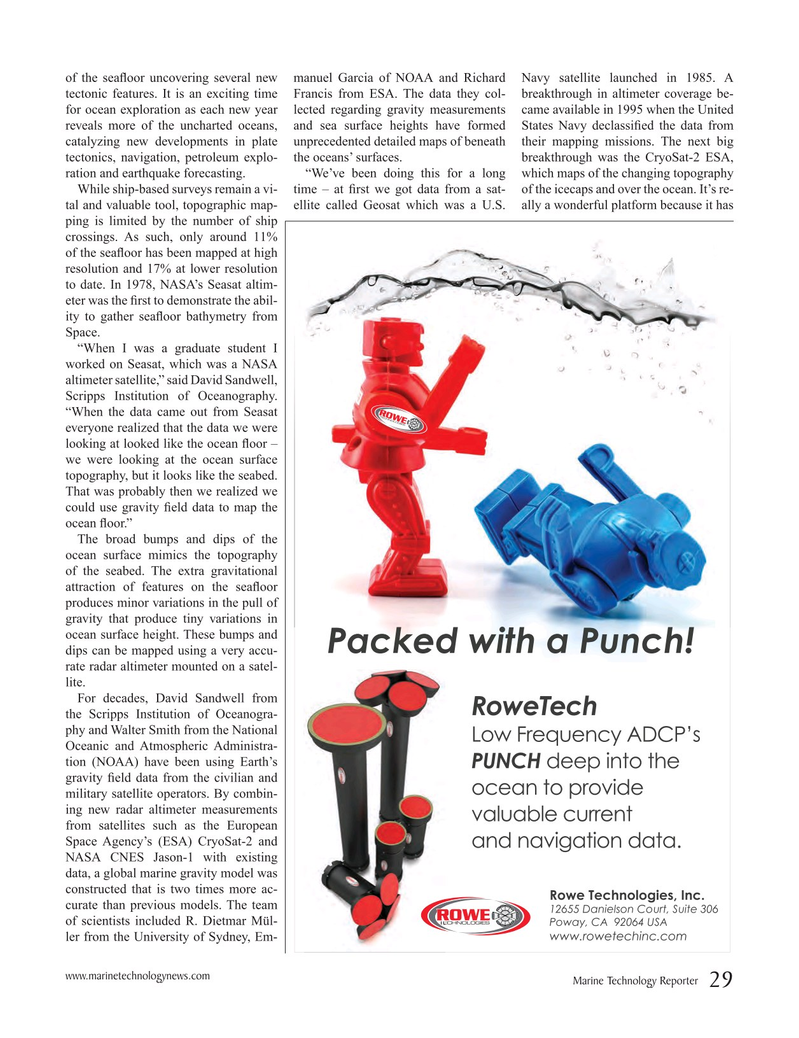
Page 29: of Marine Technology Magazine (March 2016)
Oceanographic Instrumentation: Measurement, Process & Analysis
Read this page in Pdf, Flash or Html5 edition of March 2016 Marine Technology Magazine
of the sea? oor uncovering several new manuel Garcia of NOAA and Richard Navy satellite launched in 1985. A tectonic features. It is an exciting time Francis from ESA. The data they col- breakthrough in altimeter coverage be- for ocean exploration as each new year lected regarding gravity measurements came available in 1995 when the United reveals more of the uncharted oceans, and sea surface heights have formed States Navy declassi? ed the data from catalyzing new developments in plate unprecedented detailed maps of beneath their mapping missions. The next big tectonics, navigation, petroleum explo- the oceans’ surfaces. breakthrough was the CryoSat-2 ESA, ration and earthquake forecasting. “We’ve been doing this for a long which maps of the changing topography
While ship-based surveys remain a vi- time – at ? rst we got data from a sat- of the icecaps and over the ocean. It’s re- tal and valuable tool, topographic map- ellite called Geosat which was a U.S. ally a wonderful platform because it has ping is limited by the number of ship crossings. As such, only around 11% of the sea? oor has been mapped at high resolution and 17% at lower resolution to date. In 1978, NASA’s Seasat altim- eter was the ? rst to demonstrate the abil- ity to gather sea? oor bathymetry from
Space.
“When I was a graduate student I worked on Seasat, which was a NASA altimeter satellite,” said David Sandwell,
Scripps Institution of Oceanography. “When the data came out from Seasat everyone realized that the data we were looking at looked like the ocean ? oor – we were looking at the ocean surface topography, but it looks like the seabed.
That was probably then we realized we could use gravity ? eld data to map the ocean ? oor.”
The broad bumps and dips of the ocean surface mimics the topography of the seabed. The extra gravitational attraction of features on the sea? oor produces minor variations in the pull of gravity that produce tiny variations in ocean surface height. These bumps and dips can be mapped using a very accu- rate radar altimeter mounted on a satel- lite.
For decades, David Sandwell from the Scripps Institution of Oceanogra- phy and Walter Smith from the National
Oceanic and Atmospheric Administra- tion (NOAA) have been using Earth’s gravity ? eld data from the civilian and military satellite operators. By combin- ing new radar altimeter measurements from satellites such as the European
Space Agency’s (ESA) CryoSat-2 and
NASA CNES Jason-1 with existing data, a global marine gravity model was constructed that is two times more ac- curate than previous models. The team of scientists included R. Dietmar Mül- ler from the University of Sydney, Em- www.marinetechnologynews.com
Marine Technology Reporter 29
MTR #2 (18-33).indd 29 2/19/2016 11:17:09 AM

 28
28

 30
30
